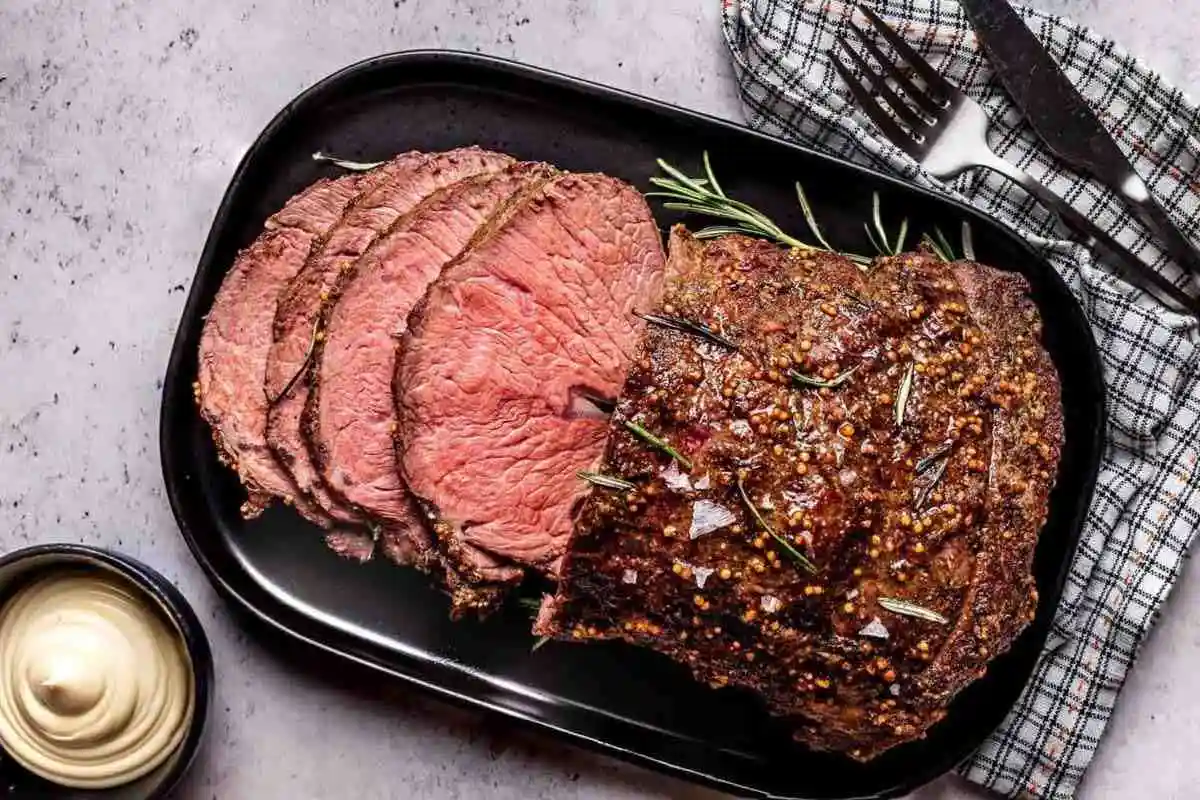a popular cut of beef, is renowned for its versatility and rich flavor. This cut, often referred to as rump roast, is a staple in many kitchens due to its ability to transform into a range of delicious dishes. From a traditional Sunday roast to savory roast beef sandwiches, the bottom round roast offers a perfect blend of taste and texture that appeals to all.
The appeal of the bottom round roast lies in its balance of lean meat and fat, which results in a juicy roast when cooked properly. Despite being a leaner cut with less beef marbling, it can become remarkably tender, making it a preferred choice for family dinners and special occasions. Understanding Beef Cuts is crucial in selecting the right piece for your meal.
Bottom round roast

One of the reasons behind the popularity of the bottom round roast is its affordability. Compared to other cuts, it offers a budget-friendly option without compromising on flavor or quality. This aspect, coupled with its tender beef texture when slow-cooked, makes it a go-to choice for those seeking both value and taste.
In the realm of comfort food, a well-prepared bottom round roast stands out. It’s not just about the meat itself but the entire experience of cooking and savoring it. The process of seasoning, roasting, and serving this cut can turn an ordinary meal into a memorable feast. The key to unlocking its full potential lies in the cooking temperature and time, which allows the flavors to develop fully.
As we delve deeper into the world of bottom round roast, we’ll explore the various aspects that make this cut a culinary delight. From preparation tips to cooking techniques, this article aims to provide a comprehensive guide to mastering the art of cooking a perfect bottom round roast.
Ingredients and Preparation of Bottom round roast
The journey to a perfect bottom round roast begins with the right ingredients and preparation. This section will guide you through the essential components and steps to prepare your roast for cooking.
Essential Ingredients:
- Bottom Round Roast Cut: The star of the dish, a well-chosen bottom round roast, is crucial. Look for a cut with an even shape and size for consistent cooking. This lean and flavorful cut, also known as a rump roast, offers a delightful balance of meat and fat.
- Seasoning: A blend of garlic, oregano, thyme, and rosemary creates a robust flavor profile. These herbs are not only aromatic but also have the ability to withstand high heat, making them ideal for roasting.
- Olive Oil and Coarse Black Pepper: Olive oil helps in creating a crispy exterior, while coarse black pepper adds a mildly hot flavor. A quality extra virgin olive oil is recommended for its subtle fruity flavor.
Preparing the Meat:
- Cleaning and Seasoning: Begin by patting the roast dry with paper towels to remove excess moisture. This step is crucial for achieving a perfect crust.
- Creating the Rub: Mix minced garlic, thyme, rosemary, and oregano with kosher salt and coarse black pepper. Brush the roast with olive oil and evenly apply the herb rub, massaging it gently into the meat.
- Refrigeration: For optimal flavor infusion, let the seasoned roast rest in the refrigerator, uncovered, for several hours. This process also helps in drying out the surface slightly, which aids in browning.
Ingredient Variations and Substitutions:
- Herbs: Feel free to experiment with other herbs like basil, marjoram, or sage. Each herb brings its unique flavor to the roast.
- Spices: For those who enjoy a bit of heat, adding crushed red pepper flakes or cayenne pepper can elevate the dish.
- Mustard: Incorporating Dijon or whole grain mustard into the rub can add tanginess and depth.
Understanding the importance of each ingredient and the preparation process is key to mastering the bottom round roast. With these steps, you’re well on your way to creating a mouth-watering dish that’s sure to impress.
Cooking Techniques of Bottom round roast
Mastering the cooking techniques for a bottom round roast is essential for achieving that perfect blend of tenderness and flavor. This section will explore various methods and provide detailed steps to ensure your roast is cooked to perfection.
Oven Roasting:
- Preheat the Oven: Start by preheating your oven. A low and slow approach is ideal for a bottom round roast, allowing the meat to cook evenly and become tender.
- Roasting: Place the roast on a wire rack in a roasting pan, fat side up. This allows the fat to render and baste the meat during cooking. Insert a meat thermometer to monitor the internal temperature.
- Cooking Time: The general guideline is to roast for about 20 minutes per pound. However, relying on a meat thermometer is the best way to ensure the desired level of doneness.
- Resting: Once the roast reaches your desired internal temperature, remove it from the oven and let it rest. This allows the juices to redistribute, resulting in a more tender and flavorful roast.
Alternative Methods:
- Slow Cooker: For a fuss-free approach, the slow cooker is an excellent option. Place the seasoned roast in the slow cooker with some beef broth and cook on low for 8-10 hours. The slow cooker method is ideal for achieving a fall-apart tender roast.
- Instant Pot: For a quicker method, the Instant Pot offers a great solution. Sear the roast on all sides using the sauté function, then cook under high pressure for about 20-25 minutes per pound. Allow for a natural pressure release to ensure tenderness.
Tips for Achieving the Perfect Roast:
- Room Temperature: Allow the roast to sit at room temperature for about 30 minutes before cooking. This helps in even cooking.
- Doneness Levels: Use a meat thermometer to check for doneness. For medium-rare, aim for an internal temperature of 135°F, and for medium, aim for 145°F.
- Slicing: Always slice the roast against the grain. This cuts through the muscle fibers, making the meat more tender and easier to chew.
By mastering these cooking techniques, you can ensure that your bottom round roast is not just cooked, but cooked to perfection. Whether you prefer the traditional oven roasting method or the convenience of a slow cooker or Instant Pot, the key is in the details of preparation and cooking.
Serving and Pairing
Once your bottom round roast is perfectly cooked, the next step is to serve and pair it with the right accompaniments to enhance its flavors. Here are some suggestions for turning your roast into a complete, delectable meal.
Recommended Side Dishes:
- Creamy Mashed Potatoes: A classic pairing, mashed potatoes offer a smooth and creamy texture that complements the robust flavors of the roast.
- Roasted Baby Potatoes: For a heartier option, try roasted baby potatoes, which add a delightful crunch and earthiness to the meal.
- Crockpot Green Beans: These are easy to prepare and add a fresh, crisp element to balance the richness of the meat.
- Skillet Sweet Potato Cornbread: A southern favorite, this dish brings a unique sweetness and a soft, crumbly texture, making it a perfect side for the savory roast.
Sauce and Condiment Pairings:
- Garlic Herb Butter: Enhance the roast’s flavor with a dollop of garlic herb butter, which melts beautifully over the hot meat.
- Horseradish Sauce: For those who enjoy a bit of a kick, horseradish sauce offers a spicy and tangy complement to the beef.
- Beef Broth Au Jus: A simple yet flavorful au jus made from beef broth can be drizzled over the sliced roast for added moisture and richness.
Presentation Tips:
- Slicing: Present the roast by slicing it thinly against the grain. This not only makes it easier to eat but also showcases the tenderness of the meat.
- Plating: Arrange the slices neatly on a platter, surrounded by your chosen side dishes. Garnish with fresh herbs for a touch of color and freshness.
With these serving and pairing ideas, your bottom round roast will be the centerpiece of a memorable meal, satisfying both the palate and the eyes.
Storage and Reheating
Proper storage and reheating are crucial for maintaining the flavor and texture of your bottom round roast. Here are some tips to ensure your leftovers are just as delicious as when they were first cooked.
Storage:
- Cooling: Allow the roast to cool completely before storing. This prevents condensation inside the container, which can make the meat soggy.
- Refrigeration: Wrap the roast tightly in aluminum foil or place it in an airtight container. Store it in the refrigerator for up to 3-4 days. For longer storage, freezing is an option. The roast can be frozen for up to 3 months.
- Slicing: If you plan to use the roast for sandwiches, consider slicing it before storing. Thinly sliced meat thaws more quickly and is ready to use.
Reheating:
- Oven Method: Preheat your oven to 250°F. Place the roast in a baking dish, adding a bit of beef broth to keep it moist. Cover with aluminum foil and heat for about 20-30 minutes, or until warmed through.
- Microwave: For a quicker option, reheat slices in the microwave. Cover them with a damp paper towel to keep the meat moist.
By following these storage and reheating guidelines, you can enjoy your bottom round roast for several days after the initial meal, with each serving as enjoyable as the first.
FAQs

In this section, we address some frequently asked questions about preparing and cooking a bottom round roast to help you achieve the best results.
Does Bottom Round Roast Get Tender?
- Yes, despite being a lean cut, the bottom round roast can become tender when cooked properly. Slow-cooking methods, like roasting at low temperatures, help break down the connective tissues, enhancing its tenderness.
Best Cooking Temperature for Tenderness?
- For optimal tenderness, cook the roast at a low temperature, around 180°F. This slow cooking process allows the meat to become tender over time without drying out.
How to Achieve Different Levels of Doneness?
- Use a meat thermometer to accurately gauge the roast’s internal temperature:
- Rare: 115°F (rest to reach 120-125°F)
- Medium Rare: 125°F (rest to reach 130-135°F)
- Medium: 135°F (rest to reach 140-145°F)
Tips for Slicing and Serving?
- Always slice the roast against the grain. This cuts through the muscle fibers, making the meat more tender and easier to chew. Thin, even slices are ideal, especially for sandwiches.
By keeping these FAQs in mind, you can ensure that your bottom round roast is not only cooked to perfection but also served in the best possible way.
Nutritional Information
The bottom round roast is not only delicious but also offers nutritional benefits. It’s a great source of high-quality protein, essential for muscle growth and repair. Additionally, this cut of beef is relatively low in fat compared to other cuts, making it a healthier option for those mindful of their fat intake.
Rich in vitamins and minerals, including iron and B vitamins, the bottom round roast supports energy production and overall health. However, it’s important to consider portion sizes and balance your meal with vegetables and whole grains for a well-rounded, nutritious diet.
Conclusion
In conclusion, the bottom round roast offers a delightful combination of flavor, versatility, and nutrition. Whether you’re preparing a family dinner or a special occasion meal, this cut of beef is sure to impress. By following the guidelines for preparation, cooking, and serving, you can transform this humble cut into a culinary masterpiece. Remember, the key to a perfect roast lies in the details – from selecting quality meat to mastering the cooking technique. Embrace the process and enjoy the delicious results of your efforts. Happy cooking!


1 thought on “Bottom Round Roast: A Comprehensive Guide”